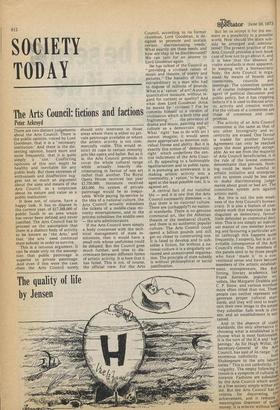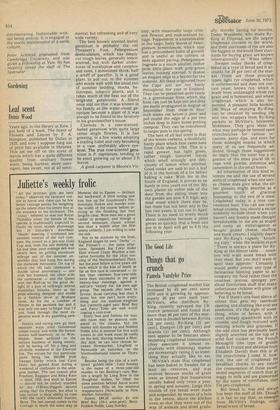SOCIETY TODAY
The Arts Council: fictions and factions
Peter. Ackroyd
There are two distinct judgements about the Arts Council. There is the public opinion, voiced by Lord Goodman, that it is a 'necessary institution.' And there is the dissenting opinion, heard more and more frequently, that it is quite simply a 'con.' Conflicting opinions of this sort might be healthy and inevitable for any public body. But these extremes of enthusiasm and disaffection suggest not so much an argument about the aims and means of the Arts Council, as a scepticism about its nature and value as a public institution.
It does not, of course, have a happy task. It has to dispose in the current year, of £17,388,000 of public funds in an area which has never been defined and never justified. The Arts Council has to proceed on the assumption that there is a distinct body of activity to be known as 'the Arts,' and that 'the arts' need continual state subsidy in order to survive.
This is a tenuous argument. It can be made only on the assumption that public patronage is superior to private patronage. And even if this were the case, 'then the Arts Council surely should only intervene in those areas where there is either no private patronage available or where the artistic activity is not commercially viable. This would restrict its cope to certain minority arts like opera and ballet. But as it is, the Arts Council pretends to cover the whole cultural range while actually heavily discriminating in favour of one art rather than another. The Royal Opera House received last year £1,750,000; literature received £83,000. No system of private patronage would be so inequitable. While paying lip-service to the idea of a national culture, the Arts Council actually subsidises the tickets of a middle-class minority entertainment, and in the process subsidises the middle-men — the arts administrators.
If the Arts Council were simply a body concerned with the technical management of state institutions, then it would have a small role whose usefulness could be debated. But the Council goes much further, and tries to discriminate between different forms of artistic activity. It is here that it has failed. This is not, of course, the official view. For the Arts
Council, according to its former chairman, Lord Goodman, is designed to promote and sustain certain 'discriminating needs.' What exactly are these needs, and how are they to be discriminated? We can turn for an answer to Lord Goodman again.
He has talked of the Council as "providing a civilised ration of music and theatre, of poetry and pictures." The banality of this is extraordinary in a man who had to dispose of millions of pounds. What is a' ration 'of art? A purely quantitative measure, without regard for content or quality? And what does Lord Goodman think he means by 'civilised '? For he commits himself to a version of civilisation which is both trite and frightening: " . the provision of drama and music, painting and all culture as a democratic right." What 'right' has to do with art I cannot imagine; it would seem more appropriate to mention individual fitness and ability. But it is exactly this notion of ' democratic right' which underlines the central indictment of the Arts Council. By appealing to a fashionable egalitarianism and to public taste, it is pursuing an irrelevance. It is making artistic activity into a commodity, a ' ration,' to be packaged at the least possible cost. It is against art. A central fact of our natiohal life — and it is one that the Arts Council necessarily dismisses — is that there is no national culture. There are (unhappily?) no nation al standards. There is no genuine communal art, like the Athenian theatre or the mediaeval church, and there is no authentic popular culture. The Arts Council could spend a billion pounds and still get no closer to constructing one.
It is fated to develop and to subsidise a fiction, for without a na tional culture it is a singularly unrooted and unmotivated organisation. The principle of state subsidy is without philosophical or social justification. But let us accept it for the moment as a possibility in a possible world. How should the state subsidy be arranged and administered? The present practice of the Arts Council provides a text-book case of how not to go about it, and it is here that the absence of viable standards is most apparent.
In keeping with a bureaucratic body, the Arts Council is orga nised by means of boards and committees, councils and meetings. The committee system is of course indispensable as an agent of political discussion and public policy, but it has crippling defects if it is used to discuss artistic activity and creative worth.
For the virtues of a committee are those of consensus and compromise.
The activity of an Arts Council committee is the same as that of any other. Incongruity and ec centricity are erased. One favour is traded for another favour.
Agreement can only be reached upon the most generally acceptable. As we see from the majority of Arts Council beneficiaries, it is the rule of the lowest common denominator that prevails. Noth ing could be more harmful to artistic initiative and enterprise. and no system could be less able to make discriminating judgements about good or bad art. The committee system acts against artistic merit.
But this is not the sole weakness of the Arts Council's bureau cracy. It is also a feature of com mittee work that nepotism can be disguised as democracy, favour itism defended as communal deci sion. This is not simply an individual matter of one member know ing and favouring a particular art ist (although this happens quite frequently, I suspect-), but is an in evitable consequence of the Arts Council's ethos. The members of the panels tend to be those people who have made it' in a con
ventional sense and have become members of the artistic establish.
ment: entrepreneurs, like ROY 'Strong, literary academics, like Frank Kermode, popular no velists, like Margaret Drabble and C. P. Snow, and various worthies more often titled than not. These people can neither represent nor generate proper cultural stay'
dards, and they will tend to main' tain. their own image in the artists
they subsidise. Safe work is chosen, and an establishment is sus' tamed.
And in ' the absence of viable standards, the only alternative t° choosing what is established is t° choose what is most fashionable. It is the turn of the ICA and' hap' penings.' As Sir Hugh Willat, the Secretary-General of the Arts Council, has said of its range: enormous catholicity . . . fro' Shakespeare to the arts labor! tories." This is not catholicity, it
vulgarity. The empty following 0 trends is a symptom of cultural 4' norance. Fashions are subsidisedd
by the Arts Council which woul, in a free society simply wither atw
die. But the Arts Council has n° criteria for discovering true achievement, and it remains .! meaningless dispenser of publv. money. It is eclectic without being
discriminating, fashionable without being serious. It is engaged in the sterile maintenance of a serile culture.
Peter Achroyd graduated from Cambridge University, and was given a fellowship at Yale. He has recently joined the staff of The Spectator



































 Previous page
Previous page